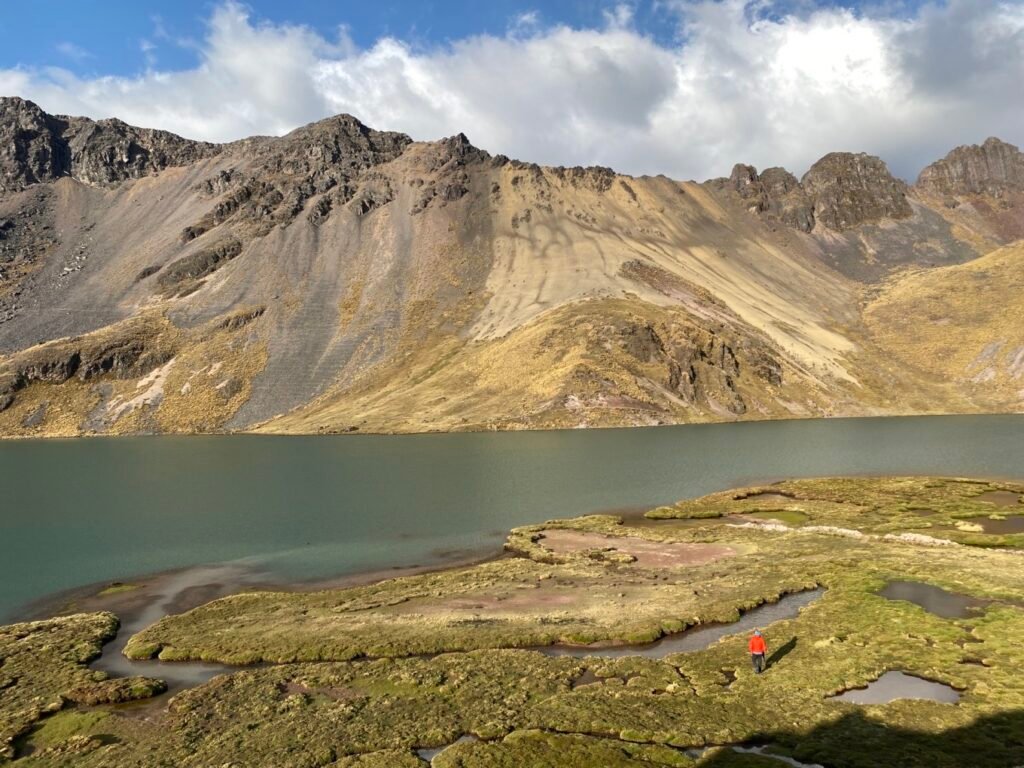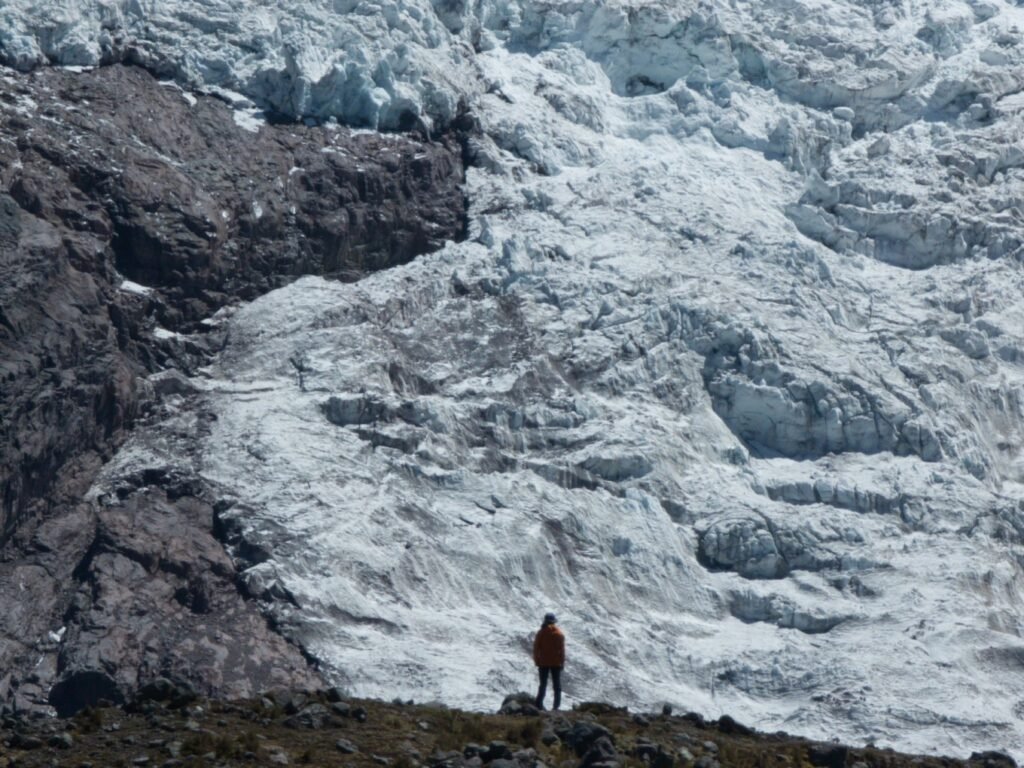Ausangate Mountain
Located 100 kilometers from Cusco, Ausangate is regarded by the Quechua people, descendants of the Incas, as one of the most sacred mountains in the Andes. Known as an Apu, or spiritual mountain, Ausangate is believed to embody a powerful spirit that provides life, water, and protection to the Quechua communities. Each year, the Quechua people undertake a pilgrimage to honor Ausangate during the Qoyllur Riti Festival, a centuries-old tradition of spiritual devotion.
The five-day trek around this 6,384-meter (20,945-foot) peak offers a breathtaking experience of the region’s natural beauty. Along the way, trekkers encounter sweeping glaciers, pristine lagoons of varying hues, the vast Andean mountain range, and the vibrant Rainbow Mountain. The journey also brings you into contact with local pastoral communities, where people continue to live in harmony with the land, herding alpacas and llamas as they have for generations.
This trek not only immerses you in the dramatic landscapes of the Andes but also provides a glimpse into the enduring culture and traditions of the Quechua people.


Ausangate Trek Overview
Ausangate Mountain is located 130 kilometers from Cusco. The trek starts in Tinki Village and ends either in Tinki or Pacchanta Village, depending on the chosen route. The highest point of the trek reaches 5,210 meters above sea level, while the lowest point is at 3,850 meters. The total distance varies between 66 and 88 kilometers, depending on the endpoint. The main challenge of the trek lies in the high altitude.
The temperature difference between day and night is significant, and the weather can change quickly, so it is essential to be prepared. On the first day, camping at UPIS Camp costs 20 PEN per person, and on the third day, camping near Ausangate Lake also costs 20 PEN per person. Gaia GPS, the paid version, is recommended as a reliable navigation tool for the trek.


Day 1: Cusco to Tinki (3,850m) – Walk to Upis Camp (4,400m) / 12 km
To begin the trek, take a bus from Cusco to Tinki. The bus departs from Av. Huayruropata 1628, Cusco, right next to the Terminal Terrestre. The fare from Cusco to Tinki is 12 PEN per person, and the journey takes around three hours. The earliest bus leaves at 4:00 a.m., and while buses generally depart every 20 minutes, some reports suggest that departures may depend on the bus filling up. We arrived at the terminal at 8:00 a.m., and our bus departed promptly at 8:23 a.m., picking up passengers along the way.
Once you arrive in Tinki, you can either walk or take a motorcycle (remember to negotiate the price) to the starting point. After reaching the village of Upis, continue along the path until you see the camp’s signage, marking the first night’s campsite.
Upis Camp offers access to natural hot springs, which are available for a fee, providing a great way to relax after the day’s hike.


Day 2: Upis Camp – Arapa Pass (4,850m) – Hatun Pucacocha Lake (4,500m) / 9.3 km
The second day involves crossing the Arapa Pass at 4,850 meters. After descending from the pass, the serene Hatun Pucacocha Lake comes into view, accompanied by the sounds of birdsong. Before 4:00 p.m., we had already set up our tent just below the lake. Initially, we considered climbing another 100 meters to a higher spot with a better view, but exhaustion got the better of us. In hindsight, this was a stroke of luck—half an hour later, a hailstorm hit, accompanied by thunder and lightning, and continued for two hours straight.


Day 3: Pacacocha Lake (4,500m) – Ausangate Apacheta Pass – Ausangate Lake – Paso Palomani Pass (5,210m) – Huchuy Finaya Village (4,600m) / 13.2 km
Today’s trek involves ascending two mountain passes, with the Palomani Pass being the highest point of the entire Ausangate trek at 5,210 meters. Standing there, the sight of the vast Ausangate glacier spreading out like a breathtaking canvas left us in awe. Along the way, we also came across a version of Rainbow Mountain, as well as stunning cinnabar-red rock walls, adding to the visual splendor.
Ideally, we should have camped at Pitoumarca, but due to exhaustion, we set up our tent in the village of Huchuy Finaya at 4,600 meters. However, early the next morning at 5:00 a.m., a local man—possibly an official—knocked on our tent and charged us 20 PEN per person for camping. In hindsight, it might have been better to push past Palomani Pass and camp around the 4,700-meter mark to avoid such surprises.
Also, note that camping near Ausangate Lake requires a fee. Be prepared to pay if you plan to stay in that area.


Day 4: Huchuy Finaya – Pitumarca – Jampa Pass (5,000m) – Jampa Camp (4,700m)
The highlight of today’s journey is Tres Picos, a series of sharp, rugged peaks that dominate the landscape. As we ascended toward Jampa Pass, the distant sight of these formidable mountains was both humbling and awe-inspiring. Along the pass, we came across numerous stone cairns carefully stacked by previous trekkers, adding a spiritual and symbolic touch to the trail.
During the descent toward Jampa Camp, we encountered several Andean chinchillas, also known as vizcachas. These quick, rabbit-like creatures darted effortlessly between the rocks, moving with impressive speed. Surprisingly, they didn’t seem afraid of people and allowed us to observe them up close without scurrying away. At first, from a distance, I mistook them for squirrels, but their unique behavior and appearance became more apparent as we got closer.



Day 5: Jampa – Qomercocha Lagoon – Pacchanta Village / 6 km
As we gazed at Ausangate Mountain from the shores of Qomercocha Lagoon, a sense of bittersweet emotion crept in, knowing that the trek was nearing its end. These four days spent immersed in the tranquility of mountains, lakes, and wildlife had felt incredibly pure and serene.
The walk from Jampa to Pacchanta took less than two hours, during which we passed over a hundred people, mostly travelers on day tours with organized groups. From Pacchanta, the 12-kilometer route to Tinki lay ahead. Just as we began the walk, a friendly local driver offered us a shared ride to Tinki for 10 PEN per person. Without hesitation, we accepted and hopped in.
Once in Tinki, we found buses returning to Cusco, with the last departure at 5:00 p.m.
If you want to avoid the crowds on the final day, it’s best to set out early. Also, Pacchanta offers natural hot springs (for a fee), which can be a perfect way to relax after the trek.


Conclusion
I feel incredibly fortunate to have experienced the Ausangate trek. Every day brought unexpected moments of breathtaking beauty. Throughout the journey, apart from the fifth day, we only encountered two other trekkers, making the solitude even more special. Just like the Huayhuash Circuit, another famous trek in Peru, Ausangate is absolutely worth the effort.
For those who want to enjoy the beauty of Ausangate without carrying heavy gear, joining a small guided group is a great option. Many travel agencies in Cusco offer such tours.
I personally skipped Rainbow Mountain on this trek due to limited energy, but it is possible to include it in the route. There’s also a six-day, five-night version of this trek that follows a similar path, offering an extended adventure for those with more time.




